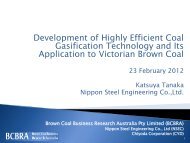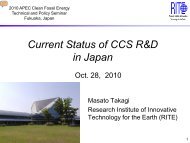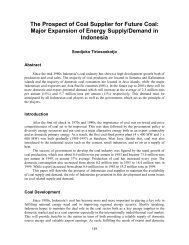Defining CCS Ready: An Approach to An International Definition
Defining CCS Ready: An Approach to An International Definition
Defining CCS Ready: An Approach to An International Definition
- No tags were found...
Create successful ePaper yourself
Turn your PDF publications into a flip-book with our unique Google optimized e-Paper software.
Appendix B: Technology Design Options for a Capture <strong>Ready</strong> Plantconcentration of approximately 55%. 151 Some systems use an amine system <strong>to</strong> recovernearly pure CO 2 , which is sold for use in beverages or dry ice. Facilities with an aminesystem will be in a position <strong>to</strong> supply CO 2 directly for compression for transport. Otherfacilities would need <strong>to</strong> add an amine unit or other system <strong>to</strong> purify the CO 2 for transport.Since hydrogen is typically produced at large chemical facilities, the required infrastructure(e.g., steam) would likely be available, though space limitations could be a consideration.Natural Gas ProcessingNatural gas leaving the well contains a variety of impurities and contaminants that must beremoved before the gas can enter the gas pipeline system. These include water, heavierhydrocarbons, CO 2 , and H 2 S, among others. Liquids can be removed at the wellhead, butgaseous components are removed at a natural gas processing plant using a variety ofcompression and sorbent technologies. The CO 2 content of the raw gas varies according <strong>to</strong>the geological source. In some cases it can be quite low, while other sources are very high.In most gas processing plants, the CO 2 and H 2 S are removed via amine sorbent systems andthe CO 2 is vented from the plant. In some cases, the CO 2 is transported by pipeline for usein enhanced oil recovery. In some cases, the CO 2 and H 2 S are reinjected as a means ofdisposing of the H 2 S. Depending on the make-up of the raw gas and the specific CO 2removal technology, a gas processing plant may already have very pure CO 2 , which is mostlikely being vented. In many cases this stream could be ready for transport and s<strong>to</strong>rage, as ishappening in some cases. One important question is the <strong>to</strong>lerance of the pipeline forcontaminants such as H 2 S. As noted above, some systems already handle mixed CO 2 andH 2 S streams; however, this might not be the case for a <strong>CCS</strong> system. In this case, the gasprocessing plant output might need additional purification.B.4.2 High Concentration SourcesThe most significant industrial source of high-concentration CO 2 streams is cement and limeproduction. Both cement and lime production involve the heating of calcium carbonate rock(CaCO 3 ) in a cement kiln at a temperature of about 1,450°C (2,400°F) <strong>to</strong> form lime (i.e.,calcium oxide or CaO) and CO 2 in a process known as calcination or calcining. In cementproduction, the lime is later combined with silica-containing materials <strong>to</strong> produce clinker (anintermediate product). The clinker is then allowed <strong>to</strong> cool, mixed with a small amount ofgypsum, and potentially other materials (e.g., slag) and used <strong>to</strong> make Portland cement. Limeis an important manufactured product with many industrial, chemical, and environmentalapplications. Its major uses are in steel making, flue gas desulfurization (FGD) systems atcoal-fired electric power plants, construction, and water purification.Cement and lime are relatively low-cost commodities. Since the raw material for cement andlime production as simply ground-up rocks, the energy input <strong>to</strong> the process is a key fac<strong>to</strong>r inproduction cost and profitability. Thus, lime and cement kilns have typically been fuelled withthe lowest-cost available fuels, most often coal and sometimes even hazardous waste.The cement kiln is basically an inclined tube in which the combustion products pass directlyover and through the carbonate rock <strong>to</strong> heat it. The exhaust gas contains the CO 2 from fuel151 Spath, P.L., & Mann, M.K.. (2001). Life cycle assessment of hydrogen production via natural gas steam reforming(Report no. NREL/TP-570-27637). Golden, CO: National Renewable Energy Labora<strong>to</strong>ry (NREL).23 February 2010 97
















